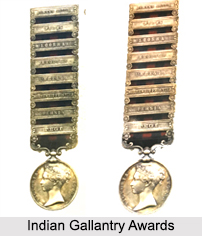 Gallantry Awards has always commanded respect and recognition. The art of appreciating the brave and gallant is not new. History defines gallantry as commanded respect and appreciation. Whether being the appointed head of a clan, raised memorials in honour of the martyrs, cash awards or medals, recognition of bravery has always been a very prestigious affair.
Gallantry Awards has always commanded respect and recognition. The art of appreciating the brave and gallant is not new. History defines gallantry as commanded respect and appreciation. Whether being the appointed head of a clan, raised memorials in honour of the martyrs, cash awards or medals, recognition of bravery has always been a very prestigious affair.
Evolution of Indian Gallantry Awards
The concept of emancipation of the brave is present in the Indian Epics too. In the Mahabharata, the merit of dying as a martyr in the cause of Dharma is all along appreciated as the easiest way to heaven. In fact, any kind of death on the battlefield was considered glorious.
In ancient times, the leadership of the clan or tribe fell upon the bravest. Indra, the most distinguished of the brave among the Indo-Aryans, became the king and the commander.
The evolution of the regular armies, however, demanded elaboration of the system of honours and awards. In the Vedic age, rewarding was done by granting a share to soldiers in the booty. Gradually some conventions with regards to the disposal of the rewards of war came to be established and the soldiers claimed a share proportionate to their contribution. In the Manu Smriti, it is laid down that rewards for chariots, elephants, parasols, animals, women and vessels should go to the brave who wins them. On the other hand, the wealth captured by the troops considered as a collective action was to be justly distributed by the ruler among them. In the Agni Purana, a ruler is advised to distribute the rewards of war among his servants in an equitable manner.
The Arthashastra of Kautilya gives an elaborate account of the Gallantry Awards. It has even been quoted which specifies the awards for various Gallant acts.
"A hundred thousand panas for slaying the enemy king; five thousand for slaying the commander-in-chief or the heir-apparent; ten thousand for slaying the chief of the brave, five thousand for destroying an elephant or a chariot, a thousand for killing a horse, a hundred for slaying the chief of the infantry, twenty for bringing a head and twice the pay in addition to whatever is seized."






